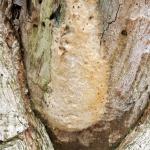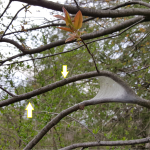Scouting for Defoliating Pests of Trees and Shrubs
Certain types of insects feed on the leaves or needles of their host plants. This can lead to either partial or complete defoliation of the host. Two orders of insects to which belong many common defoliators found in Massachusetts landscapes are the Lepidoptera (butterflies and moths) and the Hymenoptera (ants, bees, wasps, horntails, and sawflies). Certain species of defoliating caterpillars belonging to either of those orders may become problematic, if present in high enough numbers. Certain moth caterpillars, inchworms, webworms, and tent caterpillars can be found on a wide variety of hosts. Sawfly caterpillars may be found feeding on the leaves of certain deciduous plants, while other species can be seen feeding on the needles of conifers. A third order of insects also provides us with many examples of leaf feeding species: the Coleoptera (beetles). In fact, a family of beetles known as the Chrysomelidae are commonly referred to as the leaf beetles due to their dietary preferences.
What are some clues we can use to monitor for the presence of these pest insects in our landscapes? The following indicators may help:
Signs of Defoliating Pests
 Eggs – While it may not always be possible to ID an insect based on the presence of an egg, mass of eggs, or discarded eggshells alone, their presence can be helpful in alerting us to the need to continue to scout. Some insects with chewing mouthparts may eat the discarded eggshell from which they emerge thus leaving behind no clues to their presence. However, certain defoliating insect pests overwinter in the egg stage and if the eggs are distinctive enough, the insect may be identified this way. (For example, gypsy moth, eastern tent caterpillar, forest tent caterpillar, etc.)
Eggs – While it may not always be possible to ID an insect based on the presence of an egg, mass of eggs, or discarded eggshells alone, their presence can be helpful in alerting us to the need to continue to scout. Some insects with chewing mouthparts may eat the discarded eggshell from which they emerge thus leaving behind no clues to their presence. However, certain defoliating insect pests overwinter in the egg stage and if the eggs are distinctive enough, the insect may be identified this way. (For example, gypsy moth, eastern tent caterpillar, forest tent caterpillar, etc.)
- Frass – This is the excrement produced by insects that feed on solid foods, so it is typically a term used to describe solid excrement (while the liquid, sugary waste produced by piercing-sucking insect pests is called honeydew). For some species of insects, the frass they leave behind can be distinctive and can help identify them or their presence, especially if this clue is found in association with other helpful diagnostic signs.
- Shed/Cast skins (exuviae) – As insects grow and develop, they shed or molt their exoskeleton multiple times during the course of their life cycle. The cast off exoskeleton (exuviae) may be left behind by defoliators, however in some cases insects with chewing mouthparts may eat the shed skin, thus leaving behind no evidence of their presence.
 Silk – Certain defoliating insects produce silk or webbing at varying points in their life cycle. This can be a characteristic sign of some species of leafrollers, tent caterpillars, and webworms among others. It is worthwhile to note that some species of spiders use silk for various purposes. It is good to differentiate their activity, as many spiders are beneficial to our landscapes.
Silk – Certain defoliating insects produce silk or webbing at varying points in their life cycle. This can be a characteristic sign of some species of leafrollers, tent caterpillars, and webworms among others. It is worthwhile to note that some species of spiders use silk for various purposes. It is good to differentiate their activity, as many spiders are beneficial to our landscapes.
Injuries to the host plant due to defoliating pest insects may appear in various ways, including but not limited to: defoliation (of course; but this can be in part or in full; ex. some insects eat the entire leaf except leaf veins, others are messy feeders on multiple leaves, eating less tissue per leaf, etc.), leaf rolling or folding (to create shelter around them as they feed), notching of leaf margins (in part; or in full as the insect feeds from the leaf margin inward depending upon the species involved), and skeletonizing of leaf tissue.
This may not be an all-inclusive list for the types of clues that can be used to monitor for defoliating insect pests. It is also important to remember that if these signs and clues are found on a tree or shrub of value that needs to be maintained, additional steps need to be taken prior to considering management. Identifying the host plant is often the first step to take to help identify the insect in question. Once an accurate insect identification is made, this may help when planning management options. Is this an insect that is known to be particularly damaging to its hosts? Is this plant susceptible, or has pest resistance been observed? Are there cultural or mechanical management options available for this pest, and if so, is this the correct time of year to conduct them? What natural enemies are known for the pest of concern? Are these natural enemies typically able to keep the pest population below damaging levels?
If the pest is not known to be particularly deleterious to the host plant involved, additional monitoring may be necessary through the season. Additional management options may not be necessary unless the plant has a history of damage due to the pest in question, or if damaging populations of the pest are observed or expected in the current season.
Need help identifying an insect pest on a tree or shrub? Submit a sample to the UMass Plant Diagnostics Laboratory here: https://ag.umass.edu/services/plant-diagnostics-laboratory/tree-shrub-diagnostics .
Sources:
Cranshaw, Whitney, and David J. Shetlar. Garden Insects of North America:
The Ultimate Guide to Backyard Bugs. Second Edition, Princeton University Press, 2018.